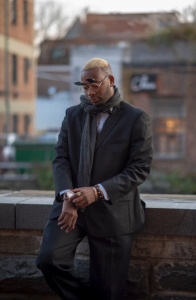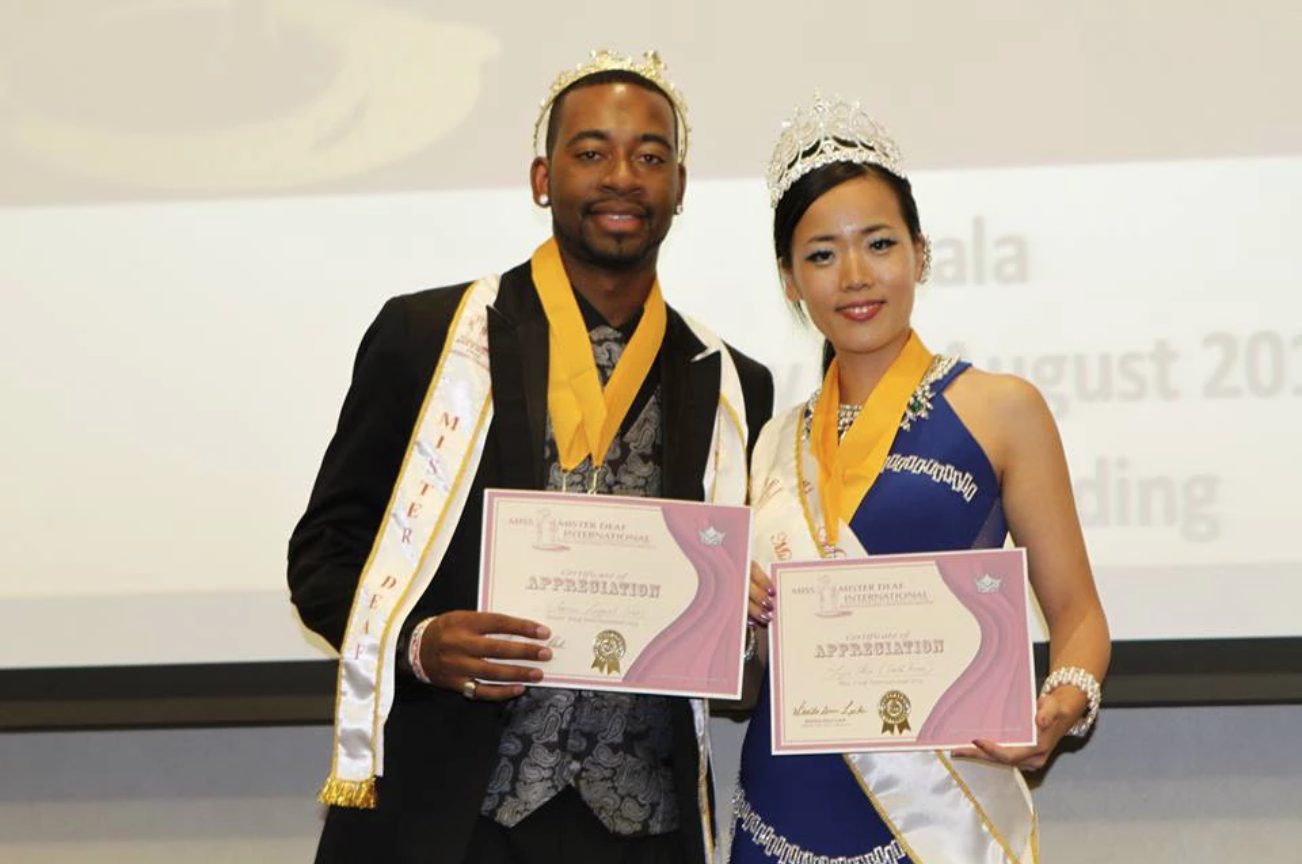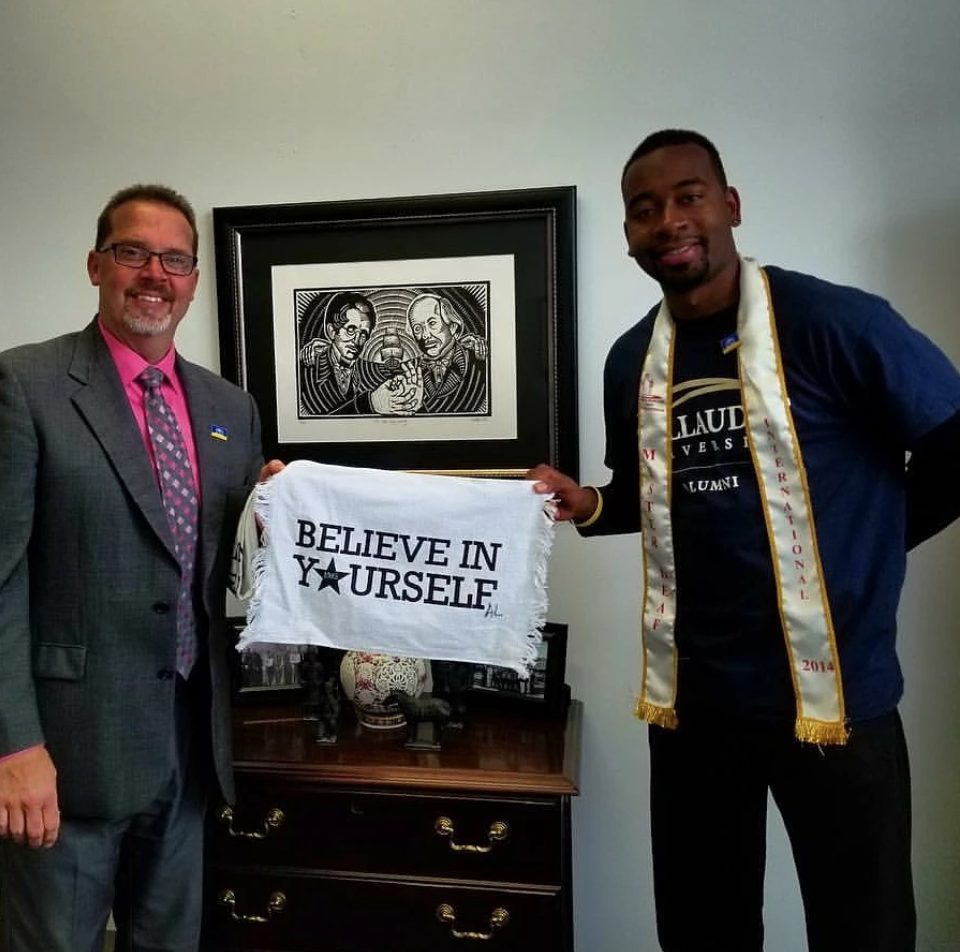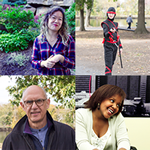Faces Behind the Screen: Aarron Loggins
Quick Links
<< Return to all “Faces Behind the Screen” stories
 Photo courtesy of aarronloggins.com
Photo courtesy of aarronloggins.com
Part 1
Aarron Loggins grew up in Chicago, Illinois. By age three his parents realized that he was hard of hearing, and the family was shocked. They were trying to say, “How do we communicate with this kid?”
“I use the term “deaf” because I’m more advertising of being proud among the community.”
At first, when they found out, they tried different sounds at home. When Aarron didn’t respond, they took him to an audiologist where they found out that he was deaf.
“So at age three, they put me into preschool with all different people who were deaf or hard of hearing. That’s when I started to learn sign language from there. But I don’t know if it’s American Sign Language or Signed English, because it was back in the ’80s so we didn’t know the term American Sign Language until I got older.”
Aarron describes himself as in both [hearing and deaf] worlds. “So when I’m in the hearing community, I’ll say that I’m deaf, because I’m deaf and proud. I’m graduated from Gallaudet University. In the deaf world, I’m more like deaf and hard of hearing.”
Below, Aarron shares his journey discovering himself as a black, deaf male, and talks about the importance of believing in yourself, and how he learned to do just that.
What is your greatest struggle?
AARRON LOGGINS: My greatest struggle is that growing up, being an African American, deaf person, in the community –when the opportunity comes, it’s like, OK, yeah, wait until next time. It really frustrated me because I wanted opportunities right away. The journey gave me experiences and taught me that I have to feel confident inside me first instead of me feeling confident outside. You have to build from the inside. Say, “OK, I can do it.” I can show it instead of doing a whole lot of talking. I’m a determined person and I have to fight for my turn. I have to fight for my dream.
I’ve fought for my dream since I was 14 years old. When I was at Dirksen Junior High School they were doing a graduation speech and audition. I decided I wanted to audition, and I’d have to speak in front of the whole, entire school – deaf, hard of hearing, and the hearing. It was a surprise because they’d never had a deaf person speak in the mainstream school.
The term is the word “persistence.” Persistence, it was just a way of life. My quote is that “Without persistence, will you give up? Yes. With persistence, then, you’ll never give up.” So I use that term from the age of 14.
I was the first male in my family who graduated from university.
At the age of 18, I graduated from mainstream school. I decided I’ve been in the mainstream for 18 years. I had never been in a deaf institution or in a private school, so Gallaudet was my first pick. The reason why I chose Gallaudet was that I wanted to build a black, deaf identity. In order to do that I’d need to find my own deaf identity.
In the mainstream, you don’t have enough of the programs for the deaf or hard of hearing – it’s limited. When I go to Gallaudet, my life changed from there – my sign language, my identity – everything changed and I could build more confidence inside. I was involved with a lot of activities, and I graduated from Gallaudet with my bachelor’s degree in theater arts. I was the first male in my family who graduated from university.
My next journey is just to keep on doing everything that I have to do. I competed for and won Mister Deaf International for the US in 2014, becoming the first African American who won Mister Deaf International. From there, that’s where my movement started – believe in yourself.
 Photo courtesy of aarronloggins.com
Photo courtesy of aarronloggins.com
Part 2
What drove you to be in the theater world, and what was that like being hard of hearing.
Aarron Loggins: I majored in Theater Art and was involved with the Gallaudet Theater. My first show was A Streetcar Named Desire back in 2006. I mean, I’m not the main character. I’m more like, you know, the underground person. So that’s like I say, you start with the underground. And then I would follow with Sign Me Alice. I don’t have a whole lot of lines. I had a few lines and stuff.
Then the following year, that was followed with A Moment in History. That’s the one that Abraham Lincoln, you know, starting to become the president. So I would play William H. Johnson, the first African American male who worked for Abraham Lincoln.
And then in 2008, I would follow with Armageddon, the Greek myth. I will play Apollo. That’s like one of the big roles for me. I had to dye my hair and wear contacts to play that character. And then the following year, after I graduated, I played Lyons in Fences.
And then the following year, I was doing a music video. So I had done theater. And I said, “You know what? I’m going to do some music videos.” So I started off with the R&B, and I started with the gospel. R&B got me – I’ve seen too many deaf rap artists. I was like, OK, it’s all standard, you know? And I wanted to open the door for the R&B, to have an R&B video. So I keep on doing R&B from 2009, 2010, 2011.
And then I can do the gospel on D-PAN. A guy named Sean Forbes, he was the founder of Deaf Professional Artists Network. You know, that day when he had an audition call, I sent my audition tape. He said, “This is amazing, man. You can make things happen.”
My dad is my number one role model. He’s the one who pushed me.
So from here, and then R&B, and then I do a little rap. And then I come to shoot pop music. I’m doing, like, a piece of old diversion music. And then from pop music, I came to international music. So the last video I posted, like, a couple of months ago is called “Famous” by French Montana. And he’s from Morocco, Africa. And he went through his struggles about his family life, his lifestyle.
And my version of being famous is that you know, I was born in Illinois. I was born in a small town. I never heard of that town. Like, you travel around the world. You were Mr. Deaf International. You had all the potential. And now, you’re meeting many people from all over the world.
Did you have any role models that you looked up to that influenced your perseverance?
AARRON LOGGINS: I had two different kinds of role models. If you’re going to speak of a hearing role model, I’d say my father. He’s my role model because he left when he was 17. He joined the military, and he sees the future for his generation.
My dad is my number one role model. He’s the one who pushed me. He said, “Aarron, you do it. I don’t care if you’re deaf or hard of hearing. You can do it.” So he is my hearing role model.
My deaf role model – I have several. My number one top role model of all is Dr. Glenn Anderson. The reason why I look up to him is that he’s from the same place where I came from. He’s from the state of Illinois – Chicago, Illinois. He was the first African American who graduated from Gallaudet with a PhD – not graduated from Gallaudet, no. He graduated with a PhD! He was the first African American who served for the board of trustees over the last 15 years. He’s been on the board of trustees for a long time.
So every time I met this guy, he gave me an explanation – you know, keep on doing. You’re making things fine for the community and stuff. So Dr. Glenn Anderson is my number one deaf role model.
 Photo courtesy of aarronloggins.com
Photo courtesy of aarronloggins.com
Part 3
Can you describe a time when you felt discriminated against for being deaf?
AARRON LOGGINS: Yeah, back in high school. In my high school, from ’99 to 2003, we didn’t have many deaf people. We had about 10 or 15 people in a group compared to 800 hearing people on the campus. In the theater group, we had about 200 people, and about two or three deaf people.
People would say the deaf students weren’t going anywhere, and things like after we graduate from high school that we’d end up working the factory line. They’d say we’d be working and mopping the floor, you know, working being a janitor, or other some small job, and that deaf people couldn’t get to a higher standard.
I told everybody at that time in 2003 that I was moving to Washington, D.C. Some people did believe me. They said, “Oh, he’s going to D.C. He’s moving for sure.” Some other people were doubtful, saying, “he’s just talking. He’s just blah, blah, blah, blah.”
So 15 years later I visited my old elementary school. The whole students were like, wow, he graduated from this school. That’s him. They showed a picture of me. And they were all like, wow. And when I went to visit the high school, they said, wow, it’s not the same person that left the school in 2003. They said that person is international. That person is big.
Believe in Yourself. I don’t just say, ok, believe in yourself. No, I show it.
So I came back, and people were like, wow, man, you’re just one of the biggest names in the town. Before, we were like, OK, whatever. You know, he’s going nowhere. He’ll be flipping burgers and fries. And then later, you know, I’m being seen on TV, I’ve been in different shows.
So I showed them. I proved them wrong that deaf people can do anything except one thing – they can’t hear.
How can someone be an advocate and ally for deaf or hard of hearing individuals?
AARRON LOGGINS: You’ve got to show them. You’ve got to say, hey, we’re all equal. The only thing is that you can hear more than I do. That’s the difference. But you have to show the message. Don’t just say the message. You have to show the message. “Hey, I want to do this. Hey, I can do this.”
Look at someone like Nyle DiMarco. He became the first deaf person to win America’s Next Top Model. He’s not just saying it. He’s showing it. He’s showing that he had that – we have that ability. He also won Dancing With the Stars. He showed the message. He didn’t say, I can do this, and just talk about it. No, he showed we have the ability.
It’s just like me – Believe in Yourself. I don’t just say, ok, believe in yourself. No, I show it. Because Believe in Yourself, now you’ve shown that, hey, we can do it. It isn’t just a message. It’s a two-way message. You can do it. You should do it. He’s not talking. He’s just showing the message, the three words: Believe in Yourself.
—
Faces Behind the Screen would like to thank Aarron Loggins for participating in our storytelling project. If you’re interested in sharing your story with us, fill out our nomination form.
Faces Behind the Screen is a storytelling project focusing on members of the Deaf and hard of hearing community.


 Photo courtesy of
Photo courtesy of  Photo courtesy of
Photo courtesy of  Photo courtesy of
Photo courtesy of 
